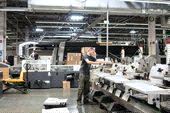Finishing & Screen Printing
Online print shop Saxoprint relies on highly efficient postpress machines from Heidelberg

Friday 23. May 2014 - A total of five Stahlfolder machines produce rapid, standardized, cost-effective folds
Thanks to minimum makeready times, two Stitchmaster ST 450 saddlestitchers significantly improve delivery times even with long runs
Large online print shops base their business model on standardized printing on mixed (gang) forms and can thus handle numerous different orders in a wide range of formats. Providers like Saxoprint in Dresden work around the clock to process between 3,000 and 4,000 jobs each day, reaching up to 400 per hour in peak times. On average, up to a dozen different motifs can be printed simultaneously on a single print sheet in 1,210 mm x 1,620 mm (47.64 x 63.78 in) format.
To separate these mixed orders back into their constituent parts, pass them to postpress, and deliver them to customers across half of Europe within just a few days of the order being placed, high-performance presses and highly efficient postpress machines are a must. For its print operations, Saxoprint relies predominantly on large-format presses from Heidelberger Druckmaschinen AG (Heidelberg). Two Speedmaster XL 162 eight-color perfecting presses are used to produce primarily flyers and folders, while an XL 145 four-color press carries out straight printing, mainly for posters.
Saxoprint installed a total of five Stahlfolder folding machines from Heidelberg a year ago – a KH 78 combination folding machine (70×100 cm format), an automated TH 82 buckle plate folding machine (also 70×100 cm format), and three automated TH 56 buckle plate folding machines in 50×70 cm format. The two big machines are mainly used to produce 16- and 32-page signatures in A5 and A4 formats, and the smaller ones exclusively for 6-page products with DL as the final format. One TH 56 can fold more than 13,000 sheets per hour.
Before making his decision to buy from Heidelberg, Klaus Sauer, the Managing Director of Saxoprint, had some tough requirements for the machines to fulfill. It was crucial that they could be integrated perfectly into the overall manufacturing process, provide consistently high throughput, and minimize makeready times by standardizing formats. “The machines had to be fast, efficient, and cost-effective,” sums up Sauer. In postpress, long makeready times are seen as one of the biggest cost drivers, particularly with complex delivery systems.
“Automating the process by storing formats and folding settings in the control system is particularly worthwhile for jobs that change frequently, such as those done on our Stahlfolder TH 82,” explains Sauer. In contrast, the Stahlfolder TH 56 buckle plate folding machines with round continuous feeder are mainly used for jobs that remain as consistent as possible, thus minimizing makeready times. These are used primarily for folding standard products like 6-page DL products or 16-page products in A4 format. Thanks to standardized processes and the shortest possible makeready times, Saxoprint achieves very high throughput – and that’s a key requirement for a print shop that prints in mass. “We are also very satisfied with the actual folding quality,” adds Sauer. There are around 200 employees in postpress at Saxoprint, working five days a week with three shifts per day.
Shorter makeready times and more flexibility also extends to saddlestitchers
The two newest saddlestitchers for collating and stitching the sheets were also supplied by Heidelberg. These two Stitchmaster ST 450 machines feature mobile feeders that can be moved between the two machines as required. The Stitchmaster ST 450 is largely designed for the needs of large bookbinders.
The sizable order volumes at Saxoprint were also one of the main reasons why the company decided to purchase two of these models one after another. As with the folding machines, frequently used settings can also be stored on the saddlestitchers and called up at the touch of a button, thus reducing makeready times and cutting costs. To standardize operations further still, one machine processes repeat jobs mainly in A4 format while the other concentrates chiefly on A5 as the final format.
With minimum makeready times, high operating speeds, and high productivity with excellent quality levels, Saxoprint boss Klaus Sauer thinks the two Stitchmaster 450 machines are the perfect saddlestitchers. “Thanks to the high throughput figures, we have become even more reliable in terms of deliveries and deadlines, even with long runs,” he emphasizes. In addition, Saxoprint has been able to further expand its range of formats, with the focus firmly on A4. For jobs with only a low page count, one machine operator supported by assistants can operate two Stitchmaster machines at the same time. That means lower personnel costs, “even if only moderately so,” concedes Sauer.
He says that the fact that all Heidelberg postpress machines share a standardized operating concept with touchscreen control system makes life far easier for his employees: “As the machines are always very similar to operate, we can be much more flexible in assigning our employees to different machines.” The two Stitchmaster ST 450 machines are already partially integrated into the digital workflow at Saxoprint. This integration process is set to be driven forward in the future to further increase transparency in postpress.
